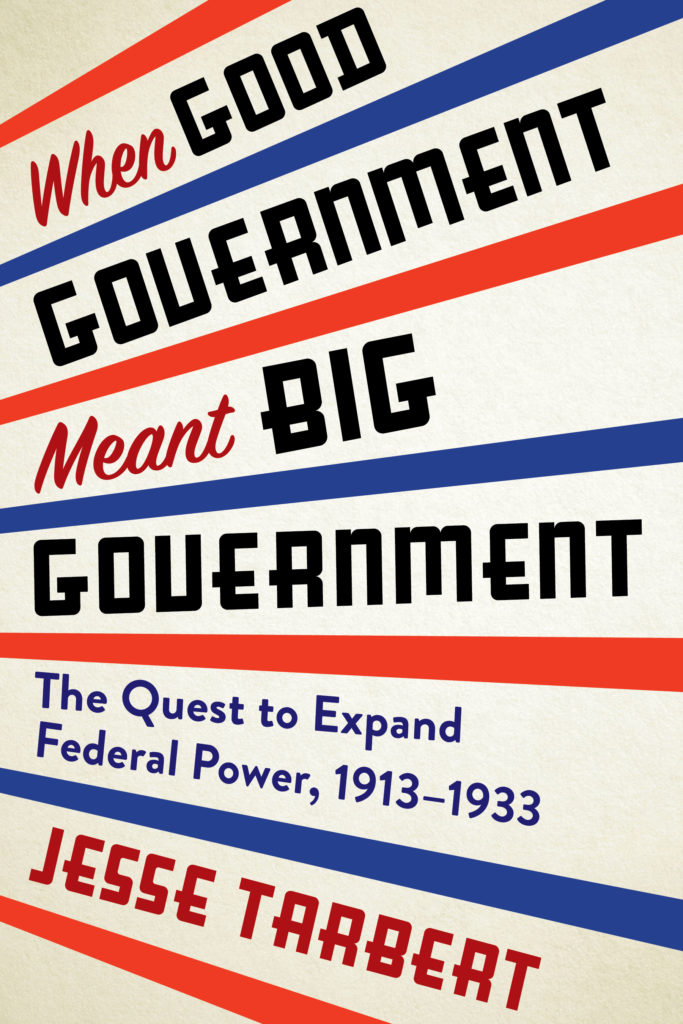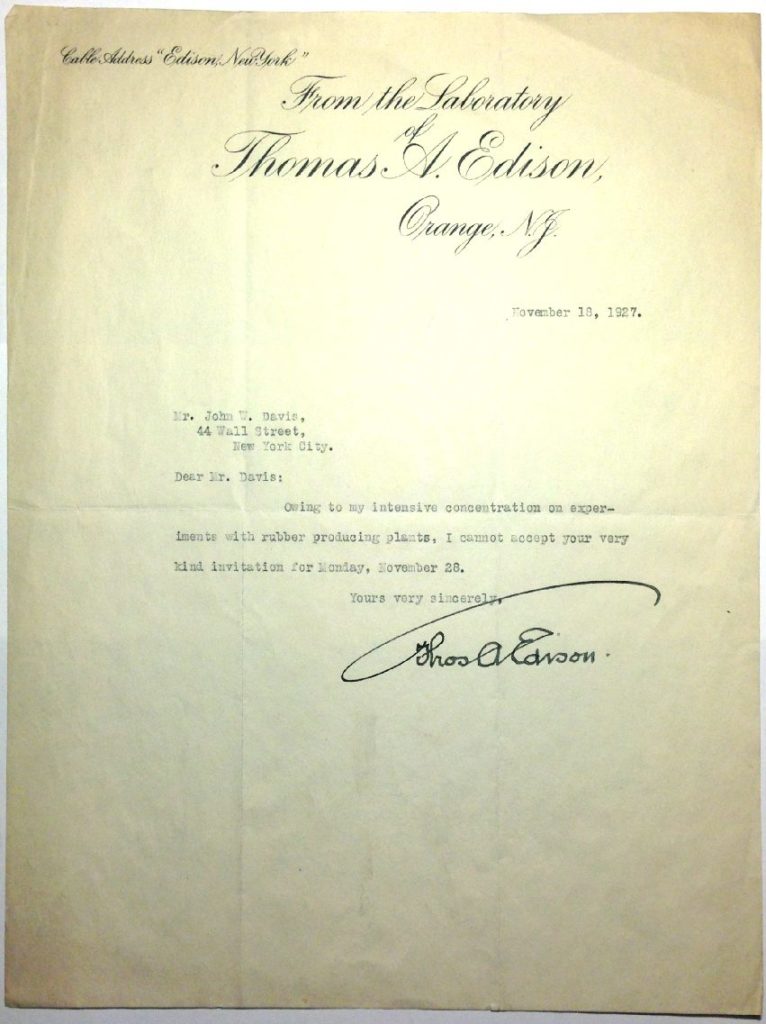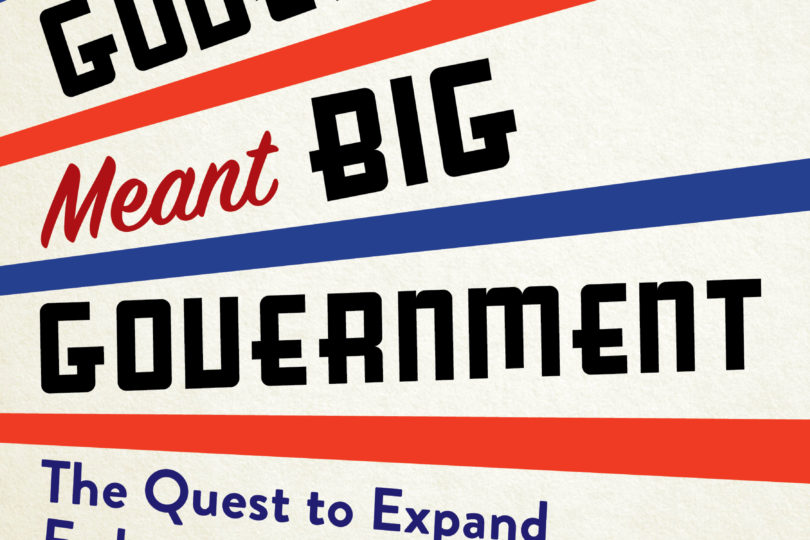
Jesse Tarbert recently took the time to discuss his new book on the history of the American state. We talked “big government,” the legacy of government reform efforts, and end with some of Jesse’s favorite spots he’s encountered throughout his career.
The Docket [TD]: Jesse, thanks so much for talking with us about your new book! Most of our readers will have assumed that “big government” was the handiwork of the American left, which sought to grow the capacity of government to deal with the stratospheric rise of modern capitalism. But your book, When Big Government Meant Good Government:The Quest to Expand Federal Power, 1913-1933, makes a different argument. Can you walk our readers through your argument about how “elite reformers” powered the rise of a new federal government in the early twentieth-century?
Jesse Tarbert [JT]: I argue that, during the first third of the twentieth century, the movement to expand the capacity of the national government was led by moderate and conservative policy advocates and policymakers with ties to Wall Street. Especially during the 1910s and 1920s, it was people like William Howard Taft, Charles Evans Hughes, Elihu Root, Charles D. Norton, and Henry L. Stimson who were the most persistent proponents of central power and national authority.
In debates in this period about budget reform, executive reorganization, veterans benefits, prohibition enforcement, antilynching, and other related topics, this group devised and promoted plans that they believed would increase national governing capacity by improving the managerial efficiency of the federal executive branch.
They saw themselves as promoting “good government” and fighting against corruption and lawlessness. They seem to have been motivated, on one level, by an understanding that modern capitalism required a modern state to support it. On another level, especially after World War One, they were motivated by the idea that the national administration could be improved by implementing managerial practices developed in corporate governance. Nowadays, it is commonplace for politicians say that government should be run like a business, and they usually mean that government should cut costs. However, in the 1910s and 1920s, people like Taft and Stimson were clear that they did not mean cost-cutting. They were interested in making government more effective and making it possible to implement national policies.
I spent a long time deciding what to call these actors before settling on “elite reformers.” Many of them have been called “progressive,” but many of their opponents were also called “progressive.” For instance, Woodrow Wilson opposed most of their proposals. I was tempted to call them “corporate elites,” but their proposals were often opposed by other actors who also fit that description. For instance, leaders of the Dupont Company fought against a number of their initiatives.
TD: One of the big moves you seem to be making is to say that the movement to expand national governing capacity emerged before the New Deal. This, too, will come as a surprise to many of our readers! How do you see the relationship between the robust reform movement you lay out in your book, and the rise of the New Deal under FDR? Is this in some ways an ‘origins story,’ or is it even bigger than that?
JT: The story in my book relates to the New Deal in several ways. The major achievement of the elite reformers was the creation of the national budget system in 1921. It is hard to imagine how the various programs of the New Deal could have been administered in the absence of a national budget system.
Also, I’m sure many readers of The Docket are familiar with the ideas about presidential administration that most scholars associate with the work of the Brownlow Committee in the mid-1930s and which were eventually enacted in the Reorganization Act of 1939. I argue that those ideas actually originated with the elite reformers in the 1910s and 1920s. In the decades before the New Deal, it was policy advocates such as Taft and Stimson who argued that increasing the managerial power of the president would improve the functioning of the government and of democracy. There are several lines of connection between the elite reformers and the Brownlow Committee, but the most obvious one is FDR himself. Although the elite reformers were predominantly Republican, FDR was one of the few Democrats to support their initiatives in the 1920s.
Finally, the “conservative coalition” of Southern Democrats and Western Republicans that opposed the New Deal grew out of the same opposition that developed in response to the elite reformers’ plans in the previous decade. The elite reformers’ support for antilynching legislation in the early 1920s solidified the sense among white Southerners that federal power posed a threat to white supremacy. That same sense animated Southern Democrats’ opposition when FDR shifted to administrative reform in the late 1930s.
TD: Your book is being published as the United States finally–hopefully!–gets a handle on a pandemic. We’ve seen the Biden administration turn to federal spending and agencies as the chief vehicles to do so. The Affordable Care Act, American Recovery and Reinvestment Act, and other measures in recent years have also seen the expansion of governmental activity in response to crises. And yet, it seems like the public discourse surrounding federal activity remains mired in an ideological morass. When did partisanship capture Americans understandings of federal governance? Do you see these perceptions changing over time?
JT: In the early stages of writing the manuscript, I planned to leave out most of the material that I had gathered about civil service reform because I thought readers might find it overly boring. I did not anticipate that the Republican Party would so completely abandon the ideal of a politically neutral civil service! Finishing the manuscript as the events of 2020 and early 2021 unfolded certainly reaffirmed my own sense that the capacity of the national government is a consequential topic. It also reaffirmed my sense that efforts to limit national governing capacity are related to racism and white nationalism.
One part of the book that might be especially surprising to readers is that I show that the administration of Warren Harding was actually the high point of Republican advocacy for federal power. At that time, both parties were split into factions that favored increasing national administrative capacity and factions that sought to constrain national administrative capacity. But an important shift begins near the end of Harding’s presidency. After debates about the Antilynching Bill in 1922 and the Immigration Act of 1924, you begin to see more bipartisan cooperation between the antigovernment factions in both parties. So, during the Coolidge administration, Republican leaders begin to be much more cautious and wary of backlash from their party’s Western wing. After 1933, the Republican party shifted more dramatically toward antigovernment politics. A good example is Robert A. Taft. In later years he was a prominent advocate of “states’ rights,” but in 1929 he had argued for establishing a national police force.
The Republican Party’s eventual total embrace of antigovernment politics took longer than it might have. It was arguably delayed by the imperatives of the Cold War. But, despite the near-100-year delay, Donald Trump’s Republican Party seems to me to be a culmination of the antigovernment alliance struck between racist Southern Democrats and white nationalist Western Republicans in the 1920s.
TD: You were a journalist in the days prior to your scholarly career. Does your experience as a journalist continue to inform your approach to historical research?
JT: Mine has not been the most practical career path, but in many ways working as a journalist was an ideal preparation for working as a historian. It has been useful, for instance, to have had fairly intensive training in how to write and in how to conduct research. It has also given me a perhaps idiosyncratic sense of what to include and what to leave out when assembling a historical narrative.
On another level, this book emerged more-or-less directly out of one of my journalistic projects. Between 2004 and 2006, I did some reporting about the government’s plans for Iraq War veterans with PTSD. That story was, alas, never published. However, it was through that project that I first developed an appreciation for the importance of administrative capacity. I also learned a lot about the history of the VA. So, when I started grad school in 2009, and started reading the literature on the history of the American state, the VA seemed like an anomaly worth investigating. How did this emblematic American bureaucracy come to be formed during the 1920s—a period that is supposed to have been a time of antistatist retrenchment? It turns out that the VA was a product of the broader movement that I describe in this book.
TD: Our readers love to learn about the nuts and bolts of scholars’ research. Where did you do most of the research for the book? What were some of the notable experiences you had while researching for the book?
JT: I was able to do a lot of the research at home, thanks to the digitization of government documents and historical newspapers. However, I also examined manuscript records from various government agencies, advocacy organizations, and individuals. If my calculations are correct, I examined about 35 manuscript collections, in 21 archival centers, in 11 states plus the District of Columbia. As anyone who has done extensive archival research knows, it can be difficult to know ahead of time what will be useful or not. Especially with the personal papers of corporate lawyers and financiers, research sometimes requires shuffling through entire boxes of invitations to annual celebrations and testimonial dinners before finding a single letter discussing policy advocacy.
For instance, I examined the papers of John W. Davis, of Davis Polk, who was the Democratic presidential nominee in 1924. Davis apparently preferred not to discuss politics or policy in his correspondence, so I did not find many letters that were useful for the book. In fact, I did not end up citing any documents from that collection. But I did find one amusing letter from 1927 where the inventor Thomas Edison offers the one of best excuses I have ever heard: “Owing to my intensive concentration on experiments with rubber producing plants, I cannot accept your very kind invitation for Monday, November 28.”

As for notable experiences, I think I might be the only person to examine the papers of the National Civil Service Reform League in their entirety. I first examined several dozen boxes at Cornell University, where I noticed that most of what was listed in the finding aid seemed to be missing. Working with an archivist there, I figured out that the bulk of the papers had been transferred to the U.S. Civil Service Commission Library in the 1960s and that they were subsequently transferred to the American Heritage Center at the University of Wyoming after the USCC was dissolved in 1979. However, after a very nice week in Laramie, I found that a large portion of the collection was still unaccounted for. During a return trip to Cornell, I found a note that said the collection had been microfilmed before it was transferred to the USCC. Another archivist found those reels sitting uncatalogued on a shelf.
TD: OK, one final question, so let’s make it a fun one. Seattle, Cleveland, Baltimore–three major cities where you’ve lived and worked. Give our readers the one place they absolutely have to visit if they make their way to these great cities.
JT: Seattle has changed a lot in the dozen years since I left. One of my favorite places, and one of the few that retains the old-time flavor of Seattle from my grandparents’ day, is Carkeek Park. If you like beaches, tide pools, wooded trails, and mountain views, and you are in North Seattle with time to spare, it is well worth a visit.
During grad school, I spent a lot of time wandering through the Cleveland Art Museum, which is across the street from Case Western Reserve University.
The Hampden neighborhood in Baltimore, not far from Johns Hopkins and Loyola, is a great place to shop and to eat, if you don’t mind hipsters. Perhaps my all-time favorite happy hour is at Rocket to Venus.
Also, I have lived close to Washington, D.C., for the past seven years. A very large percentage of the book manuscript was written in another one of my favorite spots: the atrium at the National Portrait Gallery.



